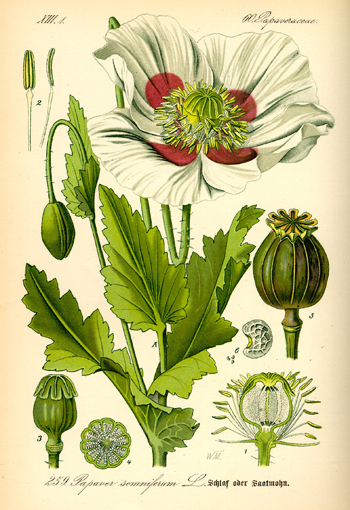Contents:
Common Names | Parts Usually Used | Plant(s) & Culture | Where Found | Medicinal Properties
Legends, Myths and Stories | Uses | Formulas or Dosages | Warning | Bibliography
Scientific Names

- Papaver somniferum L.
- Papaveraceae
- Poppy family
Common Names
- Poppy
- Ying-tzu-shu (Chinese name)
Parts Usually Used
Seeds
Back to Top
Description of Plant(s) and Culture
Opium poppy is an annual plant which grows about 1-4 feet high; its 4 petaled white or red flowers are tinged with blue and grow to 4 inches in diameter. Recognize the seedling when they appear in the spring by the blue-gray color of the leaves. It requires a long growing season, and cannot be matured in the north unless plants are started indoors. The roots are very sensitive and resent transplanting. The seedpods are large, follow the blossoms, and mature to golf-ball size.
Opium poppy is very short-lived: seedlings appear in early spring, flowers bloom in midspring, and plants see seeds in late spring and are usually gone by summer.
Different varieties have single, double, carnation, or peony forms.
Back to Top
Where Found
Native to Greece and the Orient.
Back to Top
Medicinal Properties
Hypnotic, narcotic, sedative
Back to Top
Legends, Myths and Stories
Opium is an addicting, narcotic drug prepared from the juice of the unripe seed capsules. It contains such alkaloids as morphine, codeine, and papaverine, and is used as an intoxicant and medicinally to relieve pain and produce sleep.
The word somniferum means “to make sleep”.
Back to Top
Uses
A variety of poppy plants with very flavorful seed has been developed by the Dutch from a combination of Papaver somniferum and P. rhoeas, the corn poppy. This poppy is widely grown in India, Turkey, and Persia, both for seed and for opium. The seed does not retain any of the narcotic properties, which are present only in the green seed pod. Poppy seed is used principally for baked products of all kinds. It is one of the main ingredients of commercial birdseed mixtures. Oil from crushed seed is used as a substitute for olive oil. Everyone knows of the misuse of opium; no need to detail that here.
Back to Top
Formulas or Dosages
Pods should be allowed to dry on the plant, but must be caught before they turn their saltcellar-like openings to the ground to spill their seed. Drying can be finished on muslin indoors. When the pods are crisp, seed may be removed by rubbing the pods between the palms. The tiny seed can be separated from the chaff by putting it in a coarse strainer and shaking.
Back to Top
Warning
This plant under proper medical supervision is highly valuable. Opium is addictive and overdose is fatal. Never use without medical advice.
Back to Top
Bibliography
![]() The Herb Book
The Herb Book, by John Lust, Bantam Books, 666 Fifth Avenue, New York, NY. copyright 1974.
![]() Chinese Medicinal Herbs
Chinese Medicinal Herbs, compiled by Shih-Chen Li, Georgetown Press, San Francisco, California, 1973.
Herbal Gardening, compiled by The Robison York State Herb Garden, Cornell Plantations, Matthaei Botanical Gardens of the University of Michigan, University of California Botanical Garden, Berkeley., Pantheon Books, Knopf Publishing Group, New York, 1994, first edition
![]() Indian Herbalogy of North America
Indian Herbalogy of North America, by Alma R. Hutchens, Shambala Publications, Inc., Horticultural Hall, 300 Massachusetts Avenue, Boston, Massachusetts 02115, 1973
![]() Webster’s New World Dictionary
Webster’s New World Dictionary, Third College Edition, Victoria Neufeldt, Editor in Chief, New World Dictionaries: A Division of Simon & Schuster, Inc., 15 Columbus Circle, New York, NY 10023
![]() The Yoga of Herbs: An Ayurvedic Guide to Herbal Medicine
The Yoga of Herbs: An Ayurvedic Guide to Herbal Medicine, by Dr. David Frawley & Dr. Vasant Lad, Lotus Press, Twin Lakes, Wisconsin, Second edition, 1988.
 The Rodale Herb Book: How to Use, Grow, and Buy Nature’s Miracle Plants (An Organic gardening and farming book)
The Rodale Herb Book: How to Use, Grow, and Buy Nature’s Miracle Plants (An Organic gardening and farming book), edited by William H. Hylton, Rodale Press, Inc. Emmaus, PA, 18049., 1974
